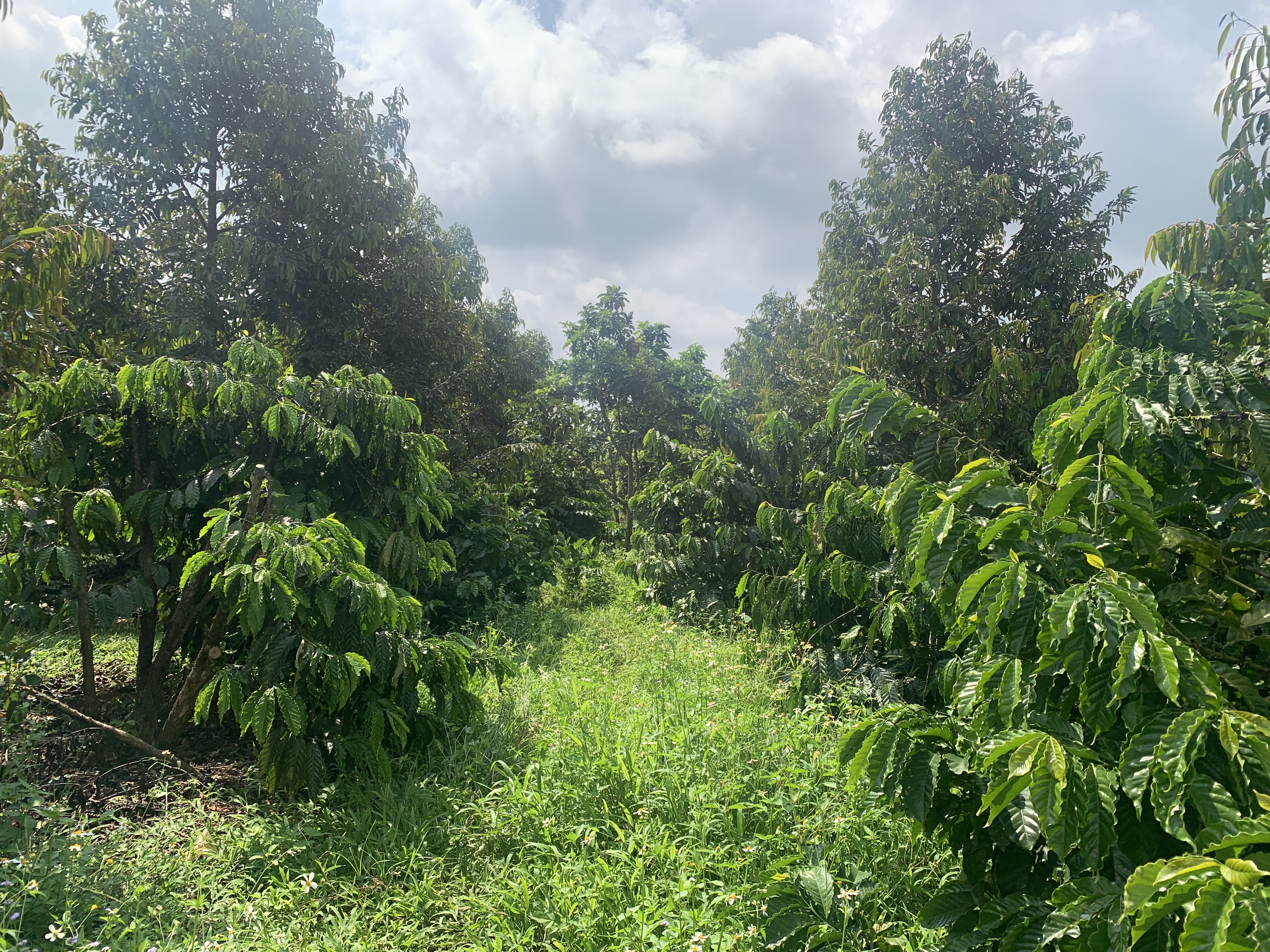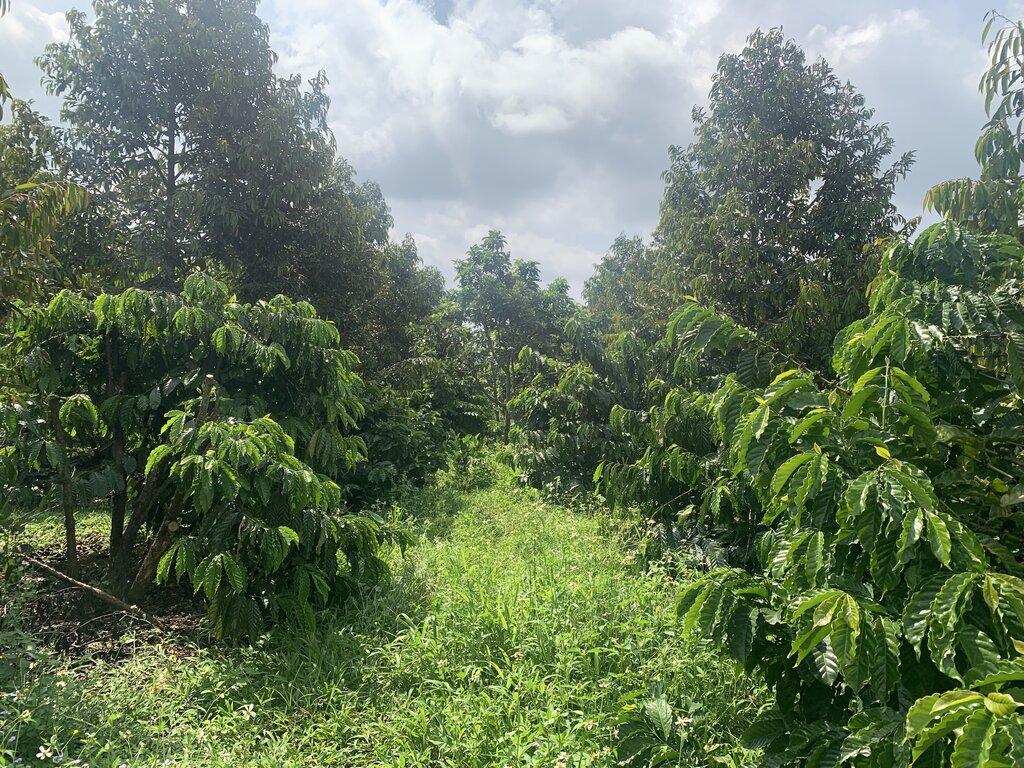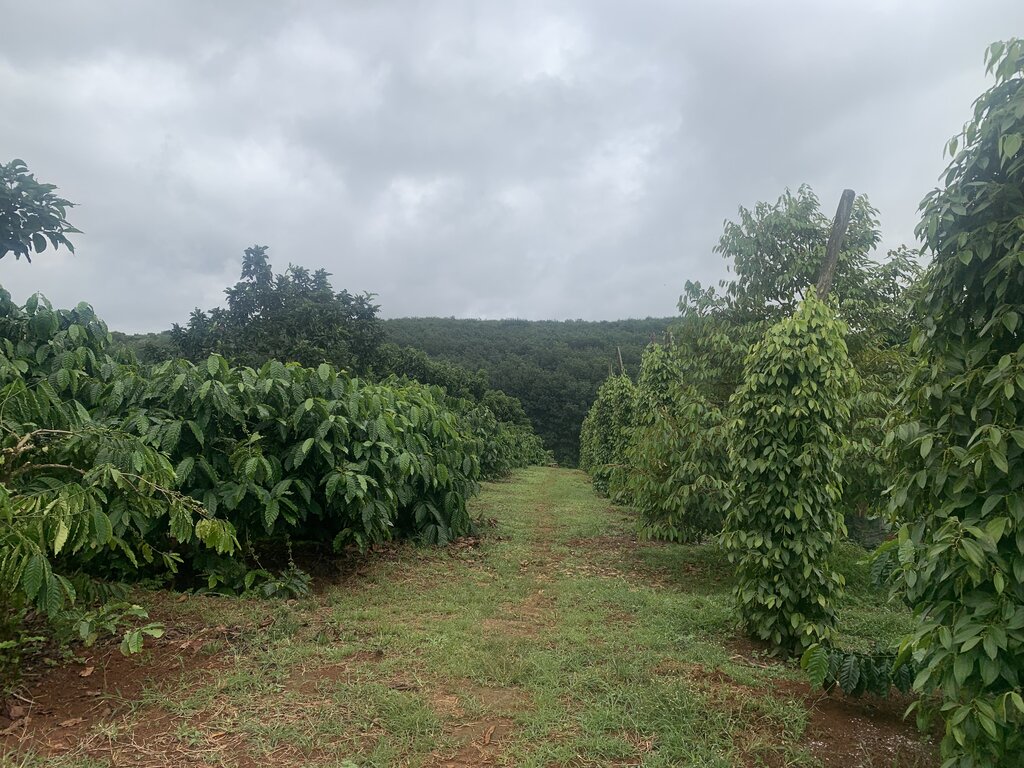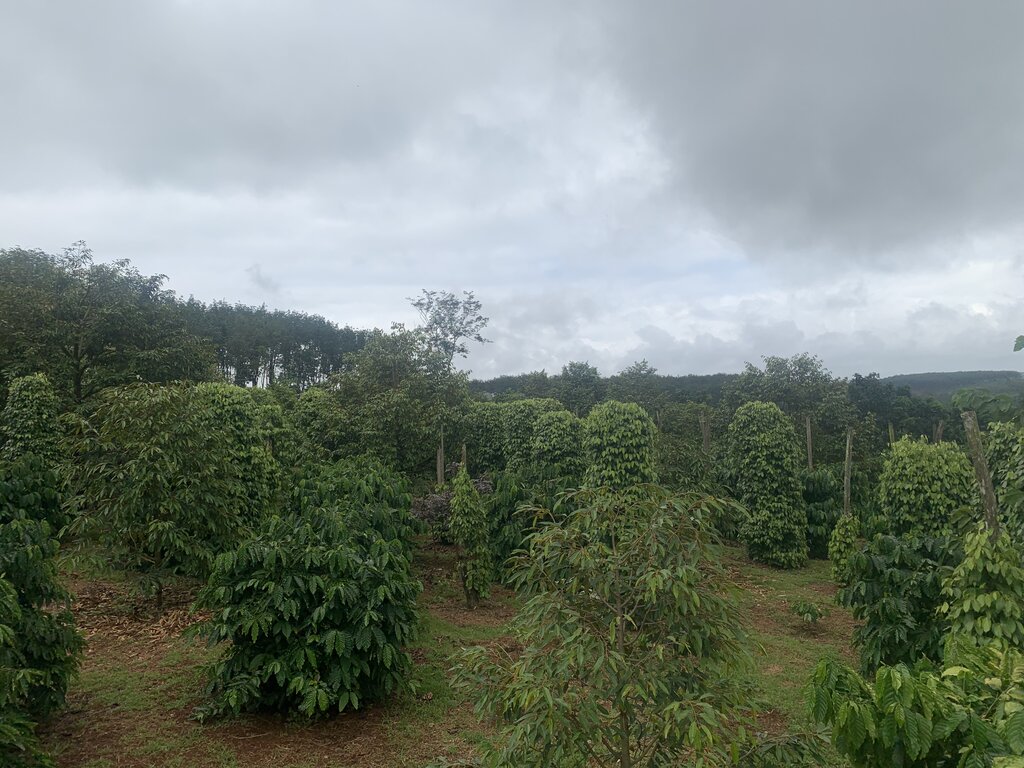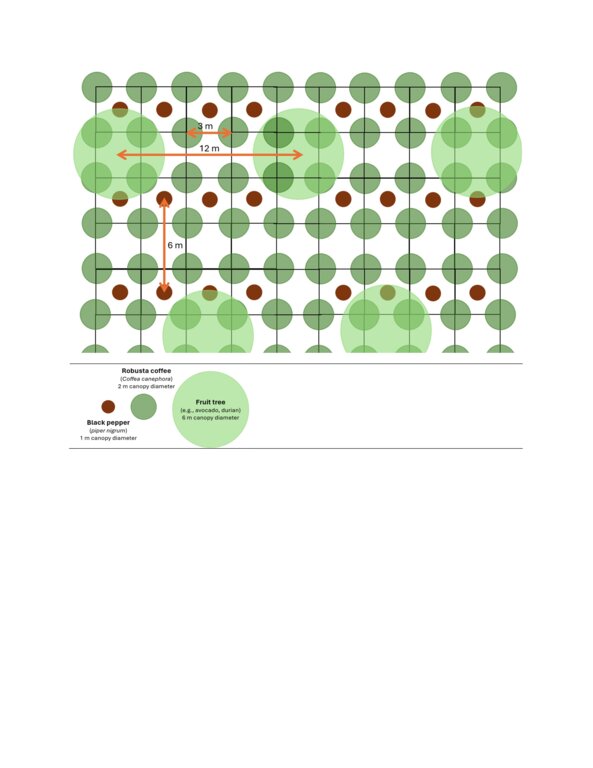Multi-storey intercropping with coffee and fruit trees [ប្រទេសវៀតណាម]
- ការបង្កើត៖
- បច្ចុប្បន្នភាព
- អ្នកចងក្រង៖ Carlos Gil Picon
- អ្នកកែសម្រួល៖ Eric Rahn
- អ្នកត្រួតពិនិត្យច្រើនទៀត៖ William Critchley, Rima Mekdaschi Studer
Mô hình trồng xen cây ăn quả trong vườn cà phê
technologies_7387 - ប្រទេសវៀតណាម
ពិនិត្យមើលគ្រប់ផ្នែក
ពង្រីកមើលទាំងអស់ បង្រួមទាំងអស់1. ព័ត៌មានទូទៅ
1.2 ព័ត៌មានលម្អិតពីបុគ្គលសំខាន់ៗ និងស្ថាប័នដែលចូលរួមក្នុងការវាយតម្លៃ និងចងក្រងឯកសារនៃបច្ចេកទេស
បុគ្គលសំខាន់ម្នាក់ (ច្រើននាក់)
co-compiler:
Ha Tuan
Nguyen University and CIAT
ប្រទេសវៀតណាម
ឈ្មោះគម្រោងដែលបានចងក្រងឯកសារ/ វាយតម្លៃលើបច្ចេកទេស (បើទាក់ទង)
Land Use Based Mitigation for Resilient Climate Pathways (LANDMARC)ឈ្មោះអង្គភាពមួយ (ច្រើន) ដែលបានចងក្រងឯកសារ/ វាយតម្លៃបច្ចេកទេស (បើទាក់ទង)
Alliance Bioversity and International Center for Tropical Agriculture -Vietnam (Alliance Bioversity-CIAT)1.3 លក្ខខណ្ឌទាក់ទងទៅនឹងការប្រើប្រាស់ទិន្នន័យដែលបានចងក្រងតាមរយៈ វ៉ូខេត
អ្នកចងក្រង និង(បុគ្គលសំខាន់ៗ)យល់ព្រមទទួលយកនូវលក្ខខណ្ឌនានាទាក់ទងទៅនឹងការប្រើប្រាស់ទិន្នន័យដែលបានចងក្រងតាមរយៈវ៉ូខេត:
បាទ/ចា៎
1.4 សេចក្តីប្រកាសស្តីពីចីរភាពនៃការពណ៌នាពីបច្ចេកទេស
តើបច្ចេកទេសដែលបានពណ៌នានេះមានបញ្ហាដែលផ្តោតលើការធ្លាក់ចុះគុណភាពដី, បើដូច្នេះវាមិនអាចត្រូវបានប្រកាសថាជាបច្ចេកទេសនៃការគ្រប់គ្រងប្រកបដោយចីរភាពទេ?
ទេ
2. ការពណ៌នាពីបច្ចេកទេស SLM
2.1 ការពណ៌នាដោយសង្ខេបពីបច្ចេកទេស
និយមន័យបច្ចេកទេស:
Robusta coffee in the Central Highlands of Vietnam is intercropped with pepper vines and fruit trees thus increasing the total planting density. This leads to higher land equivalent ratios compared to monocropping, thereby increasing land use efficiency, profitability, soil protection and resilience.
2.2 ការពណ៌នាលម្អិតពីបច្ចេកទេស
ការពណ៌នា:
Robusta coffee in the Central Highlands of Vietnam is intercropped with pepper vines and fruit trees, increasing the total planting density. This leads to higher land equivalent ratios (LER) compared to monocropping, thereby increasing land use efficiency, profitability and resilience. The increased plot-level biomass stock also confers better soil protection, and more biomass is returned to the soil through prunings and natural litter formation.
There are a variety of multi-storey intercropping designs based on coffee (Coffea canephora), black pepper (Piper nigrum), avocado (Persea americana), durian (Durio zibethinus) and macadamia (Macadamia integrifolia). An example of a recommended intercropping design is coffee with pepper vines (supported by living poles of Ceiba pentandra, Cassia siamea, Paulownia spp. etc) and fruit trees at densities of 887 coffee bushes, 336 pepper vines, 28 avocado trees and 28 durian trees per hectare (D’Haeze 2022; Rigal et al. 2023). Agronomic practices such as irrigation and nutrient management need to be adapted to this system. For example, water demand by coffee in the shade of fruit trees is less than in monocropping systems. Other practices can be combined, such as the use of cover crops (e.g., Crotalaria) planted between the other crops to avoid bare land.
This technology is increasingly applied in Dak Lak, Gia Lai, Lam Dong and Dak Nong in the Central Highlands of Vietnam, primarily by the Kinh farmers, while ethnic minorities currently rely more frequently on monocropped coffee systems.
The main purpose of this diversified mixed cropping system it to increase land use efficiency as well as productive, climatic and economic resilience. Price volatility is a huge challenge for farmers, particularly with perennial cropping systems where crop changes as response to economic signals is costly and risky due to time-lag effects.
Quality planting material (e.g., use of scion avocado cultivar 034 for grafting), water-saving irrigation systems, and organic and mineral fertilizers are required alongside a careful planting design that minimizes potential competition between associated crops. For example, the Ministry of Agriculture and Rural Development (MARD) provides guidelines (Decision No. 3702, 2018) for designing intercropping systems based on coffee.
The main benefit is economic resilience to volatile prices of perennial commodity crops. Given that perennial crops cannot be easily substituted with other crops that have better prices, diversification of cropping systems is key to economic resilience. Furthermore, land use efficiency is increased and thereby more crops can be produced using less area. Tree-level yields remain the same as in monocropping systems, however, after certain years of fruit tree growth (e.g., avocado) there is a potential of coffee tree-level yield decline due to shade effects. It also helps to manage production costs when crops need to be rejuvenated or replanted. Furthermore, carbon stocks in aboveground biomass are increased compared to monocropping systems. This increase in aboveground carbon stocks leads to higher biomass input to the soil due to fresh litter (prunings) and senescent litter (natural).
Land users choose this intercropping model to diversify their income on the same unit of land. This reduces the risks associated with unpredictable price fluctuations. They also note that this system improves resource use efficiency, requiring less fertilizers and irrigation compared to the monocropping systems.
2.3 រូបភាពនៃបច្ចេកទេស
2.5 ប្រទេស/តំបន់/ទីតាំងកន្លែង ដែលបច្ចេកទេសត្រូវបានអនុវត្ត និងបានគ្រប់ដណ្តប់ដោយការវាយតម្លៃនេះ
ប្រទេស:
ប្រទេសវៀតណាម
តំបន់/រដ្ឋ/ខេត្ត:
Dak Nong
បញ្ជាក់បន្ថែមពីលក្ខណៈនៃទីតាំង:
Hung Binh commune
បញ្ជាក់ពីការសាយភាយនៃបច្ចេកទេស:
- ត្រូវបានផ្សព្វផ្សាយត្រឹមតំបន់មួយ
ប្រសិនបើមិនច្បាស់ពីទំហំផ្ទៃដី សូមធ្វើការប៉ាន់ប្រម៉ាណ:
- 100-1,000 គម2
តើបច្ចេកទេស (មួយ ឬច្រើន) ទាំងនោះស្ថិតនៅក្នុងតំបន់ការពារជាអចិន្ត្រៃយ៍ណាមួយដែរឬទេ?
ទេ
Map
×2.6 កាលបរិច្ឆេទនៃការអនុវត្ត
ប្រសិនបើមិនច្បាស់ឆ្នាំ សូមបញ្ជាក់កាលបរិច្ឆេទដែលប្រហាក់ប្រហែល:
- 10-50 ឆ្នាំ
2.7 ការណែនាំពីបច្ចេកទេស
សូមបញ្ជាក់តើបច្ចេកទេសត្រូវបានណែនាំឱ្យអនុវត្តដោយរបៀបណា:
- តាមរយៈការបង្កើតថ្មីរបស់អ្នកប្រើប្រាស់ដី
- តាមរយៈគម្រោង / អន្តរាគមន៍ពីខាងក្រៅ
មតិយោបល់ (ប្រភេទនៃគម្រោង ។ល។):
Next to land user's own innovation, the technology is also being introduced and promoted by the department of crop production of the Ministry of Agriculture and Rural Development (MARD) and the extension systems after refinement through research institutions under MARD such as WASI in the Central Highlands. Furthermore, it is also being introduced by Universities and companies.
3. ចំណាត់ថ្នាក់នៃបច្ចេកទេស SLM
3.1 គោលបំណងចម្បង (១ ឬច្រើន) នៃបច្ចេកទេសនេះ
- កាត់បន្ថយ, បង្ការ, ស្តារឡើងវិញនូវការធ្លាក់ចុះគុណភាពដី
- បន្ស៊ាំទៅនឹងការប្រែប្រួលអាកាសធាតុ/គ្រោះមហន្តរាយ និងផលប៉ះពាល់របស់វា
- បង្កើតផលប្រយោជន៍សេដ្ឋកិច្ច
- Reduce economic risks due to price volatility
3.2 ប្រភេទដីប្រើប្រាស់មួយប្រភេទ (ច្រើនប្រភេទ) ដែលបានអនុវត្តបច្ចេកទេស
ដីប្រើប្រាស់ចម្រុះនៅលើដីតែមួយ:
បាទ/ចា៎
បញ្ជាក់ពីប្រភេទដីច្រើនប្រភេទ (ដីដាំដំណាំ/ដីចិញ្ចឹមសត្វ/ដីព្រៃឈើ):
- កសិរុក្ខកម្ម

ដីដាំដំណាំ
សូមបញ្ជាក់:
this questionnaire refers to a variety of crops with different growing season characteristics
តើជាការអនុវត្តន៍ដំណាំចន្លោះ?
បាទ/ចា៎
ប្រសិនបើបាទ/ច៎ា សូមបញ្ជាក់ប្រភេទដំណាំដែលដាំចន្លោះគ្នានោះ:
Coffee (Coffea canephora), black pepper (Peper nigrum) poles (Ceiba pentandra; Cassia Siamea; Paulownia spp.), avocado (Persea americana, durian (Durio zibethinus), macadamia (Macadamia integrifolia).
តើជាការអនុវត្តន៍ដំណាំវិលជុំ?
ទេ
3.3 បន្ទាប់ពីអនុវត្តបច្ចេកទេស តើដីប្រើប្រាស់មានការប្រែប្រួលដែររឺទេ?
បន្ទាប់ពីអនុវត្តបច្ចេកទេស តើដីប្រើប្រាស់មានការប្រែប្រួលដែររឺទេ?
- ទេ (បន្តទៅសំណួរ 3.4)
ដីប្រើប្រាស់ចម្រុះនៅលើដីតែមួយ:
ទេ

ដីដាំដំណាំ
- ដំណាំរយៈពេលវែង (មិនមែនឈើ)
- ប្រភេទដើមឈើធំៗ និងដើមឈើតូចៗ
តើជាការអនុវត្តន៍ដំណាំចន្លោះ?
ទេ
តើជាការអនុវត្តន៍ដំណាំវិលជុំ?
ទេ
3.4 ការផ្គត់ផ្គង់ទឹក
ការផ្គត់ផ្គង់ទឹកនៅកន្លែងអនុវត្តបច្ចេកទេស:
- ទឹកភ្លៀង និងប្រព័ន្ធស្រោចស្រព
3.5 ក្រុម SLM ដែលបច្ចេកទេសស្ថិតនៅក្នុង
- កសិរុក្ខកម្ម
- ធ្វើឱ្យប្រសើរឡើងគម្របដី/ ដំណាំគម្របដី
3.6 វិធានការ SLM ដែលបញ្ចូលនូវបច្ចេកទេស

វិធានការក្សេត្រសាស្ត្រ
- A2: សារធាតុសរីរាង្គ/ជីជាតិដី

វិធានការគ្រប់គ្រង
- M1: ការផ្លាស់ប្តូរប្រភេទដីប្រើប្រាស់
មតិយោបល់:
Composting using agricultural residues, and a change from mono-cropping to agroforestry
3.7 កំណត់ប្រភេទនៃការធ្លាក់ចុះគុណភាពដីសំខាន់ៗដែលបច្ចេកទេសនេះបានដោះស្រាយ

ការហូរច្រោះដីដោយសារទឹក
- Wt: ការបាត់ដីស្រទាប់លើដោយការហូរច្រោះ

ការបាត់បង់ទឹក
- Ha: ការថយចុះសំណើមដី
មតិយោបល់:
Intercropping in combination with cover crops, Intercropping and cover cropping helps increase soil moisture.
3.8 ការពារ កាត់បន្ថយ ឬស្តារឡើងវិញនៃការធ្លាក់ចុះគុណភាពដី
បញ្ជាក់ពីគោលដៅរបស់បច្ចេកទេស ដែលផ្តោតទៅការធ្លាក់ចុះគុណភាពដី:
- ការការពារការធ្លាក់ចុះគុណភាពដី
មតិយោបល់:
While the main goal of land users in adopting this technology is to diversify income sources and reduce risks related to price volatility, it also reduces soil degradation by leaving less soil bare compared with the interrows of monocropped coffee and increases biomass input to the soil.
4. បច្ចេកទេសជាក់លាក់ សកម្មភាពអនុវត្ត ធាតុចូល និងថ្លៃដើម
4.1 គំនូសបច្ចេកទេសនៃបច្ចេកទេសនេះ
លក្ខណៈពិសេសនៃបច្ចេកទេស (ទាក់ទងនឺងគំនូរបច្ចេកទេស):
Planting density of coffee (Coffea canephora) is 3m by 3m. Coffee trees typically grow to a height of 1.5 to 2m, with a canopy width of around 2m. For the associated tree species, the densities depend on the species and the number of species. For example, black pepper (piper nigrum) can be intercropped at a density of 9m x 9m on living tree poles such as Cassia Siamea, Leucena Leucocephala, etc. Pepper vines grow up to 5 m in height and can also be planted at higher density (e.g. 6 x 3m) at the expense of fruit trees. Avocado (Persea americana), Durian (Durio zibethinus), and macadamia (Macadamia integrifolia) can be intercropped at 12m x 12m. These fruit trees share similar sizes and shapes and grow to a height ranging from 5-10m, with a canopy spanning from 6-8m. The study by Rigal et al. (2023) provide a great overview of the diversity of intercropping / agroforestry designs with different species mixtures and planting densities: Rigal C., Duong T., Vo C., Bon L.V., Hoang q.T., Chau T.M.L. (2023) Transitioning from monoculture to mixed cropping systems: The case of coffee, pepper, and fruit trees in Vietnam. Ecological Economics 214:107980.
ឈ្មោះអ្នកនិពន្ធ:
Own illustration based on Rigal et al. (2023) and MARD: Good Agricultural Practices for Robusta Coffee Production.
4.2 ព័ត៌មានទូទៅដែលពាក់ព័ន្ធនឹងការគណនាធាតុចូល និងថ្លៃដើម
កំណត់របៀបនៃការគណនាថ្លៃដើម និងធាតុចូល:
- ក្នុងតំបន់អនុវត្តបច្ចេកទេស
កំណត់ទំហំ និងឯកត្តាផ្ទៃដី:
1 hectare
កំណត់រូបិយប័ណ្ណសម្រាប់ថ្លៃដើម:
- ដុល្លារ
កំណត់ថ្លៃឈ្នួលជាមធ្យមនៃការជួលកម្លាំងពលកម្មក្នុងមួយថ្ងៃ:
12
4.3 សកម្មភាពបង្កើត
| សកម្មភាព | រយៈពេល (រដូវកាល) | |
|---|---|---|
| 1. | Nursery with grafted material | Dry season |
| 2. | Soil preparation | April or May; before the onset of the rainy season |
| 3. | Planting | rainy season |
| 4. | Fertilizer application | rainy season |
| 5. | irrigation | dry season |
មតិយោបល់:
Establishment will take 3 years until first coffee harvests. Harvests of other fruit trees will start later.
4.4 ថ្លៃដើម និងធាតុចូលដែលត្រូវការសម្រាប់ការបង្កើតបច្ចេកទេស
ប្រសិនបើមិនអាចបំបែកតម្លៃដើមក្នុងតារាងខាងក្រោមទេ សូមផ្តល់នូវតម្លៃប៉ាន់ស្មានសរុបក្នុងការបង្កើតបច្ចេកទេសនោះ:
7000,0
មតិយោបល់:
This estimate is based on a system of 887 coffee plants, 336 pepper vines, 28 avocado trees (based on grafting with improved variety) and 28 durian trees.
4.5 សកម្មភាពថែទាំ
| សកម្មភាព | ពេលវេលា/ ភាពញឹកញាប់ | |
|---|---|---|
| 1. | Creating a basin around the tree base for keeping water during irrigation phase | |
| 2. | Application of fertilizers and pesticides | |
| 3. | Irrigation | |
| 4. | Weeding and pruning | |
| 5. | Guiding the black pepper vines onto the poles and trimming branches of living poles | |
| 6. | Tying durian fruits to branches by plastic ropes for support | |
| 7. | Sanitation after each harvest |
4.6 កំណត់ថ្លៃដើមសម្រាប់ការថែទាំ/ សកម្មភាពរបស់បច្ចេកទេស (ក្នុងរយៈពេលមួយឆ្នាំ)
ប្រសិនបើមិនអាចបំបែកតម្លៃដើមក្នុងតារាងខាងក្រោមទេ សូមផ្តល់នូវតម្លៃប៉ាន់ស្មានសរុបក្នុងការថែទាំបច្ចេកទេសនោះ:
4000,0
មតិយោបល់:
The maintenance costs refer to the establishment stage (first 3 years) until first harvest and are based on a system of 887 coffee plants, 336 pepper vines, 28 avocado trees (based on grafting with improved variety) and 28 durian trees.
4.7 កត្តាសំខាន់បំផុតដែលមានឥទ្ធិពលដល់ការចំណាយ
ពណ៌នាពីកត្តាប៉ះពាល់ចម្បងៗទៅលើថ្លៃដើម:
production inputs (fertilizers, pesticides), and hired labor. Initial establishment cost of irrigation systems is also costly.
5. លក្ខណៈបរិស្ថានធម្មជាតិ និងមនុស្ស
5.1 អាកាសធាតុ
បរិមាណទឹកភ្លៀងប្រចាំឆ្នាំ
- < 250 មម
- 251-500 មម
- 501-750 មម
- 751-1,000 មម
- 1,001-1,500 មម
- 1,501-2,000 មម
- 2,001-3,000 មម
- 3,001-4,000 មម
- > 4,000 មម
តំបន់កសិអាកាសធាតុ
- សើម
5.2 សណ្ឋានដី
ជម្រាលជាមធ្យម:
- រាបស្មើ (0-2%)
- ជម្រាលតិចតួច (3-5%)
- មធ្យម (6-10%)
- ជម្រាលខ្ពស់បន្តិច (11-15%)
- ទីទួល (16-30%)
- ទីទួលចោត (31-60%)
- ទីទួលចោតខ្លាំង (>60%)
ទម្រង់ដី:
- ខ្ពង់រាប
- កំពូលភ្នំ
- ជម្រាលភ្នំ
- ជម្រាលទួល
- ជម្រាលជើងភ្នំ
- បាតជ្រលងភ្នំ
តំបន់តាមរយៈកម្ពស់ :
- 0-100 ម
- 101-500 ម
- 501-1,000 ម
- 1,001-1,500 ម
- 1,501-2,000 ម
- 2,001-2,500 ម
- 2,501-3,000 ម
- 3,001-4,000 ម
- > 4,000 ម
បញ្ជាក់ថាតើបច្ចេកទេសនេះត្រូវបានអនុវត្តន៍នៅក្នុង:
- មិនពាក់ព័ន្ធទាំងអស់
5.3 ដី
ជម្រៅដីជាមធ្យម:
- រាក់ខ្លាំង (0-20 សម)
- រាក់ (21-50 សម)
- មធ្យម (51-80 សម)
- ជ្រៅ (81-120 សម)
- ជ្រៅខ្លាំង (> 120 សម)
វាយនភាពដី (ស្រទាប់លើ):
- មធ្យម (ល្បាយ, ល្បាប់)
វាយនភាពដី (> 20 សម ស្រទាប់ក្នុង):
- មធ្យម (ល្បាយ, ល្បាប់)
5.4 ទឹកដែលអាចទាញមកប្រើប្រាស់បាន និងគុណភាពទឹក
នីវ៉ូទឹកក្រោមដី:
> 50 ម
ទឹកលើដីដែលអាចទាញយកប្រើប្រាស់បាន:
មិនមាន/ គ្មាន
គុណភាពទឹក (មិនបានធ្វើប្រត្តិកម្ម):
ទឹកពិសារដែលមានគុណភាពល្អ
តើមានបញ្ហាភាពទឹកប្រៃហូរចូលមកដែរឬទេ?
ទេ
តើទឹកជំនន់កំពុងកើតមាននៅតំបន់នេះដែររឺទេ?
ទេ
5.5 ជីវៈចម្រុះ
ភាពសម្បូរបែបនៃប្រភេទ:
- កម្រិតមធ្យម
ភាពសម្បូរបែបនៃទីជម្រក:
- កម្រិតមធ្យម
មតិយោបល់ និងលក្ខណៈពិសេសផ្សេងទៀតលើជីវចម្រុះ:
Considering that it is relative to other sites of the region, I would classify it as medium. Forests have highest diversity, and the mixed coffee agroforestry systems have medium diversity. While other agricultural land has low diversity.
5.6 លក្ខណៈនៃអ្នកប្រើប្រាស់ដីដែលអនុវត្តបច្ចេកទេស
នៅមួយកន្លែង ឬពនេចរ :
- នៅមួយកន្លែង
ទីផ្សារនៃប្រព័ន្ធផលិតកម្ម:
- ពាណិជ្ជកម្ម/ ទីផ្សារ
ចំណូលក្រៅកសិកម្ម:
- 10-50% នៃចំណូល
កម្រិតជីវភាព:
- មធ្យម
ឯកជន ឬក្រុម:
- ធ្វើខ្លួនឯង/ គ្រួសារ
កម្រិតប្រើប្រាស់គ្រឿងយន្ត:
- ប្រើកម្លាំងពលកម្ម
យេនឌ័រ:
- ស្ត្រី
- បុរស
អាយុរបស់អ្នកប្រើប្រាស់ដី:
- វ័យកណ្តាល
- មនុស្សចាស់
5.7 ទំហំផ្ទៃដីជាមធ្យមនៃដីប្រើប្រាស់ដោយអ្នកប្រើប្រាស់ដី ក្នុងការអនុវត្តបច្ចេកទេស
- < 0.5 ហិកតា
- 0.5-1 ហិកតា
- 1-2 ហិកតា
- 2-5 ហិកតា
- 5-15 ហិកតា
- 15-50 ហិកតា
- 50-100 ហិកតា
- 100-500 ហិកតា
- 500-1,000 ហិកតា
- 1,000-10,000 ហិកតា
- > 10,000 ហិកតា
តើផ្ទៃដីនេះចាត់ទុកជាទំហំកម្រិតណាដែរ ខ្នាតតូច មធ្យម ឬខ្នាតធំ (ធៀបនឹងបរិបទតំបន់)?
- ខ្នាតមធ្យម
5.8 ភាពជាម្ចាស់ដី កម្មសិទ្ធប្រើប្រាស់ដី និងកម្មសិទ្ធប្រើប្រាស់ទឹក
ភាពជាម្ចាស់ដី:
- ឯកជន មិនមានកម្មសិទ្ធ
- ឯកជន មានកម្មសិទ្ធ
កម្មសិទ្ធិប្រើប្រាស់ដី:
- ឯកជន
កម្មសិទ្ធប្រើប្រាស់ទឹក:
- អាស្រ័យផលសេរី (មិនមានការកំណត់)
5.9 ការប្រើប្រាស់សេវាកម្ម និងហេដ្ឋារចនាសម្ព័ន្ធ
សុខភាព:
- មិនល្អ
- មធ្យម
- ល្អ
ការអប់រំ:
- មិនល្អ
- មធ្យម
- ល្អ
ជំនួយបច្ចេកទេស:
- មិនល្អ
- មធ្យម
- ល្អ
ការងារ (ឧ. ការងារក្រៅកសិដ្ឋាន):
- មិនល្អ
- មធ្យម
- ល្អ
ទីផ្សារ:
- មិនល្អ
- មធ្យម
- ល្អ
ថាមពល:
- មិនល្អ
- មធ្យម
- ល្អ
ផ្លូវ និងការដឹកជញ្ជូន:
- មិនល្អ
- មធ្យម
- ល្អ
ទឹកផឹក និងអនាម័យ:
- មិនល្អ
- មធ្យម
- ល្អ
សេវាកម្មហិរញ្ញវត្ថុ:
- មិនល្អ
- មធ្យម
- ល្អ
6. ផលប៉ះពាល់ និងការសន្និដ្ឋាន
6.1 ផលប៉ះពាល់ក្នុងបរិវេណអនុវត្តបច្ចេកទេសដែលកើតមាន
ផលប៉ះពាល់លើសេដ្ឋកិច្ចសង្គម
ផលិតផល
ផលិតកម្មដំណាំ
មតិយោបល់/ ការបញ្ជាក់:
Profitability and risk mitigation has increased, which is the main reason why there is adoption at scale.
ហានិភ័យនៃភាពបរាជ័យរបស់ផលិតកម្ម
មតិយោបល់/ ការបញ្ជាក់:
Profitability and risk mitigation has increased, which is the main reason why there is adoption at scale.
ភាពសម្បូរបែបនៃផលិតផល
មតិយោបល់/ ការបញ្ជាក់:
Product diversity could still be increased.
ចំណូល និងថ្លៃដើម
ចំណូលក្នុងកសិដ្ឋាន
មតិយោបល់/ ការបញ្ជាក់:
Costs increase initially, but over time the benefits outweigh the costs. In some cases, external financial support is needed to adopt the practice.
ភាពសម្បូរបែបប្រភពប្រាក់ចំណូល
មតិយោបល់/ ការបញ្ជាក់:
Income sources increase from 1 (i.e., coffee) to several (e.g., pepper, avocado, durian).
បន្ទុកការងារ
មតិយោបល់/ ការបញ្ជាក់:
Work efficiency increases when intercropping, compared to having the crops separately on different fields as monocrops. Nonetheless, the workload is larger when simply comparing to 1 coffee monocropping field.
ផលប៉ះពាល់ទៅលើអេកូឡូស៊ី
ដី
សំណើមដី
មតិយោបល់/ ការបញ្ជាក់:
Soil moisture increases due to the change in microclimate from shade trees and cover crops.
គម្របដី
មតិយោបល់/ ការបញ្ជាក់:
Soil cover increases through the use of selective weeding or cover crops. Current practices often leave their soils bare exposing them to erosion during heavy rainfall.
ជីវចម្រុះ៖ ដំណាំ, សត្វ
ដំណាំគម្រប
មតិយោបល់/ ការបញ្ជាក់:
Vegetation cover increases, which is particularly beneficial for soil conservation.
ជីវម៉ាស/ កាបូនលើដី
មតិយោបល់/ ការបញ្ជាក់:
Above- and belowground C increases, however there is potential to integrate additional trees with higher biomass values.
ភាពសម្បូរបែបនៃរុក្ខជាតិ
មតិយោបល់/ ការបញ្ជាក់:
Plant diversity increases. However there is potential to further increase the diversity on the farm.
ការកាត់បន្ថយហានិភ័យនៃគ្រោះមហន្តរាយ និងគ្រោះអាកាសធាតុ
ផលប៉ះពាល់នៃគ្រោះរាំងស្ងួត
មតិយោបល់/ ការបញ្ជាក់:
Microclimate benefits from shade trees reduce the impact of droughts.
បញ្ជាក់ពីការប៉ាន់ស្មាននៃផលប៉ះពាល់ក្នុងបរិវេណអនុវត្តបច្ចេកទេស (វាស់វែង):
Combination of literature studies (e.g., Rigal et al. 2023; D'haeze 2022) and own (yet) unpublished observations.
- Rigal C., Duong T., Vo C., Bon L.V., Hoang q.T., Chau T.M.L. (2023)
Transitioning from Monoculture to Mixed Cropping Systems: The Case of Coffee, Pepper, and Fruit Trees in Vietnam,
Ecological Economics 214:107980
- D’haeze, D. (2022). Optimizing water use in the central highlands of Viet Nam: Focus on
the Robusta coffee sector. Hanoi, Viet Nam: IUCN and Gland, Switzerland.
6.2 ផលប៉ះពាល់ក្រៅបរិវេណអនុវត្តបច្ចេកទេសដែលកើតមាន
Buffering/សមត្ថភាពចម្រោះ
មតិយោបល់/ ការបញ្ជាក់:
Increased soil cover improves soil properties and filtering capacity.
វាយតម្លៃផលប៉ះពាល់ក្រៅបរិវេណអនុវត្តបច្ចេកទេស (វាស់វែង):
Literature based and own observations.
For example:
-Cannavo, P., Sansoulet, J., Harmand, J.-M., Siles, P., Dreyer, E., & Vaast, P. (2011). Agroforestry associating coffee and Inga densiflora results in complementarity for water uptake and decreases deep drainage in Costa Rica. Agriculture, Ecosystems & Environment, 140(1–2), 1–13. https://doi.org/10.1016/j.agee.2010.11.005
- Chatterjee, N., Nair, P. K. R., Nair, V. D., Bhattacharjee, A., Filho, E. D. M. V., Muschler, R. G., & Noponen, M. R. A. (2019). Do Coffee Agroforestry Systems Always Improve Soil Carbon Stocks Deeper in the Soil?—A Case Study from Turrialba, Costa Rica. Forests, 11(1), 49. https://doi.org/10.3390/f11010049
6.3 ភាពប្រឈម និងភាពរួសនៃបច្ចេកទេសទៅនឹងការប្រែប្រួលអាកាសធាតុ និងគ្រោះអាកាសធាតុ/ គ្រោះមហន្តរាយ (ដែលដឹងដោយអ្នកប្រើប្រាស់ដី)
ការប្រែប្រួលអាកាសធាតុ
ការប្រែប្រួលអាកាសធាតុ
| រដូវកាល | កើនឡើង ឬថយចុះ | លក្ខណៈឆ្លើយតបនៃបច្ចេកទេសទៅនឹងការប្រែប្រួលអាកាសធាតុ | |
|---|---|---|---|
| សីតុណ្ហភាពប្រចាំឆ្នាំ | កើនឡើង | មធ្យម | |
| សីតុណ្ហភាពប្រចាំរដូវកាល | រដូវក្តៅ | កើនឡើង | មធ្យម |
| បរិមាណទឹកភ្លៀងប្រចាំរដូវកាល | រដូវប្រាំង | កើនឡើង | ល្អ |
គ្រោះអាកាសធាតុ (មហន្តរាយ)
គ្រោះមហន្តរាយអាកាសធាតុ
| លក្ខណៈឆ្លើយតបនៃបច្ចេកទេសទៅនឹងការប្រែប្រួលអាកាសធាតុ | |
|---|---|
| រាំងស្ងួត | មធ្យម |
គ្រោះមហន្តរាយទឹក
| លក្ខណៈឆ្លើយតបនៃបច្ចេកទេសទៅនឹងការប្រែប្រួលអាកាសធាតុ | |
|---|---|
| ដីបាក់ | មធ្យម |
គ្រោះមហន្តរាយជីវៈសាស្ត្រ
| លក្ខណៈឆ្លើយតបនៃបច្ចេកទេសទៅនឹងការប្រែប្រួលអាកាសធាតុ | |
|---|---|
| ការមានបញ្ហាសត្វល្អិត/ដង្កូវ | ល្អ |
មតិយោបល់:
The practice is considered an important climate change adaptation strategy, however, more research is needed to provide the the required evidence.
6.4 ការវិភាគថ្លៃដើម និងអត្ថប្រយោជន៍
តើផលចំណេញ និងថ្លៃដើមត្រូវបានប្រៀបធៀបគ្នាយ៉ាងដូចម្តេច (ទស្សនៈរបស់អ្នកប្រើប្រាស់ដី)?
រយៈពេលខ្លី:
អវិជ្ជមាន
រយៈពេលវែង:
វិជ្ជមាន
តើផលចំណេញ និងការថែទាំ/ ជួសជុលត្រូវបានប្រៀបធៀបគ្នាយ៉ាងដូចម្តេច (ទស្សនៈរបស់អ្នកប្រើប្រាស់ដី)?
រយៈពេលខ្លី:
អវិជ្ជមាន
រយៈពេលវែង:
វិជ្ជមាន
មតិយោបល់:
It can take between 5 to 10 years until the relative advantage is achieved, as the associated crops first need to reach their productive stage. Hence, investment costs will be higher until the associated crops can be harvested.
6.5 ការទទួលយកបច្ចេកទេស
- 11-50%
ក្នុងចំណោមគ្រួសារទាំងអស់ដែលបានអនុវត្តបច្ចេកទេស តើមានប៉ុន្មានគ្រួសារដែលចង់ធ្វើដោយខ្លួនឯង ដោយមិនទទួលបានសម្ភារៈលើកទឹកចិត្ត/ប្រាក់ឧបត្ថម្ភ?:
- 51-90%
6.6 ការបន្សុំា
តើថ្មីៗនេះ បច្ចេកទេសនេះត្រូវបានកែតម្រូវដើម្បីបន្ស៊ាំទៅនឹងស្ថានភាពប្រែប្រួលដែរឬទេ?
បាទ/ចា៎
បើឆ្លើយបាទ/ ចា៎ សូមកំណត់ថាតើស្ថានភាពប្រែប្រួលមួយណាត្រូវបានបន្ស៊ាំ:
- បម្រែបម្រួលទីផ្សារ
បញ្ជាក់ពីការបន្ស៊ាំនៃបច្ចេកទេស (ការរៀបចំ, ឧបករណ៍/ប្រភេទ ។ល។):
Farmers are very sensitive to market signals. For example, the price of durian has increased, so farmers plant more durian. Earlier the same happened with pepper.
6.7 ភាពខ្លាំង/ គុណសម្បត្តិ/ ឱកាសនៃបច្ចេកទេស
| ភាពខ្លាំង/ គុណសម្បត្តិ/ ឱកាសនៅកន្លែងរបស់អ្នកប្រើប្រាស់ដី |
|---|
| The main advantage is the increased profitability and market/climate risk management. |
| There are additional benefits such as improvement in soil ecology to manage soil-borne pests and diseases and reduced irrigation need for coffee. |
| Interest from coffee buyers in sustainable production systems provides another incentive to change practices. |
| ភាពខ្លាំង/ គុណសម្បត្តិ/ ឱកាស ទស្សនៈរបស់បុគ្គលសំខាន់ៗ |
|---|
| More resilient livelihoods |
| More diversified landscapes |
| Increased carbon storage capacity |
6.8 ភាពខ្សោយ/ គុណវិបត្តិ/ ហានិភ័យនៃបច្ចេកទេស និងវិធីសាស្ត្រដោះស្រាយ
| ភាពខ្សោយ/ គុណវិបត្តិ/ ហានិភ័យ ទស្សនៈរបស់អ្នកប្រើប្រាស់ដី | តើបច្ចេកទេសទាំងនោះបានដោះស្រាយបញ្ហាដូចម្តេច? |
|---|---|
| Initial investment costs can be high for some smallholder farmers | External financial support is needed through market mechanisms. |
| There continues to be a need to adapt agronomic practices to the new system design. This knowledge is not yet fully available. | Research activities to provide the required evidence and enable the development of guidelines. |
| ភាពខ្សោយ/ គុណវិបត្តិ/ ហានិភ័យ ទស្សនៈរបស់អ្នកចងក្រងឬបុគ្គលសំខាន់ៗ | តើបច្ចេកទេសទាំងនោះបានដោះស្រាយបញ្ហាដូចម្តេច? |
|---|---|
| There continues to be a need to adapt agronomic practices to the new system design. This knowledge is not yet fully available. | Research activities to provide the required evidence and enable the development of guidelines. |
7. ឯកសារយោង និងវេបសាយ
7.1 វិធីសាស្ត្រ/ ប្រភពនៃព័ត៌មាន
- តាមការចុះទីវាល ការស្រាវជ្រាវនៅទីវាល
- ការសម្ភាសន៍ជាមួយអ្នកប្រើប្រាស់ដី
7.3 ការភ្ជាប់ទៅកាន់ព័ត៌មានពាក់ព័ន្ធលើប្រព័ន្ធអនឡាញ
ចំណងជើង/ ពណ៌នា:
Rigal et al. (2023) Transitioning from monoculture to mixed cropping systems: the case of coffee, pepper, and fruit trees in Vietnam
វេបសាយ:
https://doi.org/10.1016/j.ecolecon.2023.107980
ចំណងជើង/ ពណ៌នា:
Dave D'Haeze (2022) Optimizing water use in the Central Highlands of Viet Nam. Focus on the Robusta coffee sector
វេបសាយ:
https://iucn.org/sites/default/files/content/documents/2022/bridge_ch_coffee_transformation_final_february_2022-_revised_2_ddh_for_publication.pdf
ចំណងជើង/ ពណ៌នា:
MARD (2003) Good Agricultural Practices for Robusta Coffee Production.
ការតភ្ជាប់ និងម៉ូឌុល
ពង្រីកមើលទាំងអស់ បង្រួមទាំងអស់ការតភ្ជាប់
គ្មានការតភ្ជាប់
ម៉ូឌុល
គ្មានម៉ូឌុល


